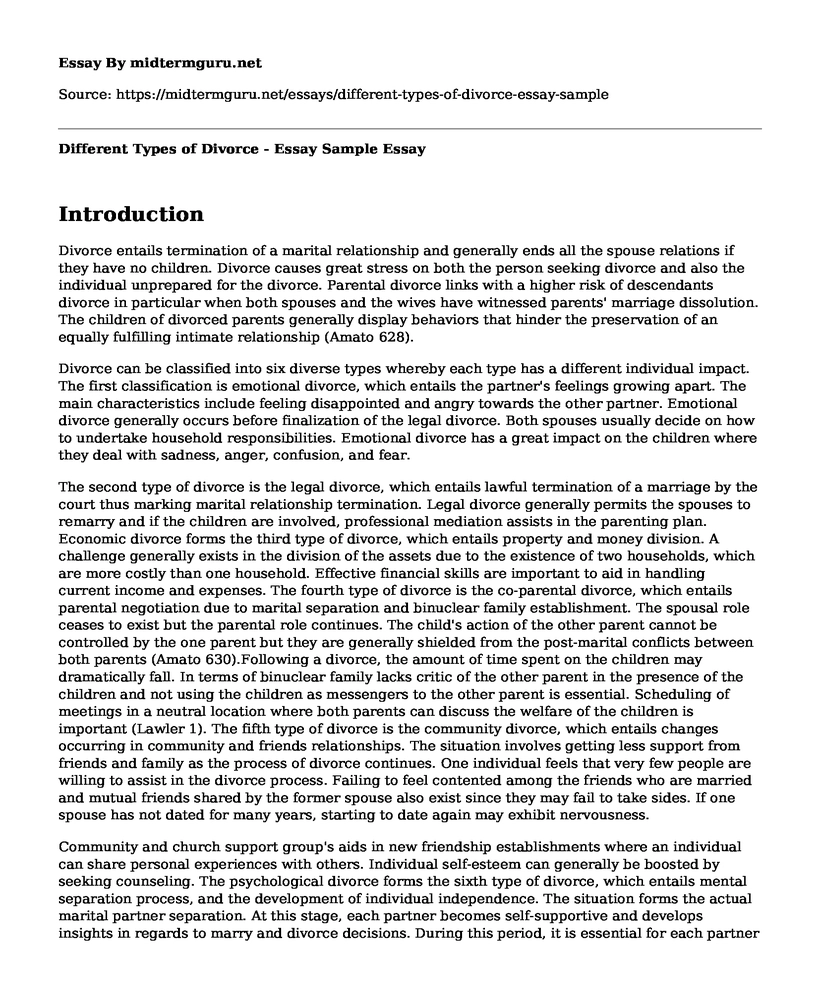Introduction
Divorce entails termination of a marital relationship and generally ends all the spouse relations if they have no children. Divorce causes great stress on both the person seeking divorce and also the individual unprepared for the divorce. Parental divorce links with a higher risk of descendants divorce in particular when both spouses and the wives have witnessed parents' marriage dissolution. The children of divorced parents generally display behaviors that hinder the preservation of an equally fulfilling intimate relationship (Amato 628).
Divorce can be classified into six diverse types whereby each type has a different individual impact. The first classification is emotional divorce, which entails the partner's feelings growing apart. The main characteristics include feeling disappointed and angry towards the other partner. Emotional divorce generally occurs before finalization of the legal divorce. Both spouses usually decide on how to undertake household responsibilities. Emotional divorce has a great impact on the children where they deal with sadness, anger, confusion, and fear.
The second type of divorce is the legal divorce, which entails lawful termination of a marriage by the court thus marking marital relationship termination. Legal divorce generally permits the spouses to remarry and if the children are involved, professional mediation assists in the parenting plan. Economic divorce forms the third type of divorce, which entails property and money division. A challenge generally exists in the division of the assets due to the existence of two households, which are more costly than one household. Effective financial skills are important to aid in handling current income and expenses. The fourth type of divorce is the co-parental divorce, which entails parental negotiation due to marital separation and binuclear family establishment. The spousal role ceases to exist but the parental role continues. The child's action of the other parent cannot be controlled by the one parent but they are generally shielded from the post-marital conflicts between both parents (Amato 630).Following a divorce, the amount of time spent on the children may dramatically fall. In terms of binuclear family lacks critic of the other parent in the presence of the children and not using the children as messengers to the other parent is essential. Scheduling of meetings in a neutral location where both parents can discuss the welfare of the children is important (Lawler 1). The fifth type of divorce is the community divorce, which entails changes occurring in community and friends relationships. The situation involves getting less support from friends and family as the process of divorce continues. One individual feels that very few people are willing to assist in the divorce process. Failing to feel contented among the friends who are married and mutual friends shared by the former spouse also exist since they may fail to take sides. If one spouse has not dated for many years, starting to date again may exhibit nervousness.
Community and church support group's aids in new friendship establishments where an individual can share personal experiences with others. Individual self-esteem can generally be boosted by seeking counseling. The psychological divorce forms the sixth type of divorce, which entails mental separation process, and the development of individual independence. The situation forms the actual marital partner separation. At this stage, each partner becomes self-supportive and develops insights in regards to marry and divorce decisions. During this period, it is essential for each partner to stop blaming each other but adapt to the divorce and also identify new methods of relating to each other (Lawler 2).
Conclusion
In conclusion, each individual must accept that the marriage is over and make peace with the children if they exist. Support network establishment and future goals development are essential after divorce.
Works Cited
Amato, Paul R. "Explaining the intergenerational transmission of divorce." Journal of Marriage and the Family, 1996, pp. 628-640.
Lawler, Mary K. Transitioning Through Divorce. "The Six Types of Divorce." Oklahoma Cooperative Extension Fact Sheets, 2001.
Cite this page
Different Types of Divorce - Essay Sample. (2023, Jan 15). Retrieved from https://midtermguru.com/essays/different-types-of-divorce-essay-sample
If you are the original author of this essay and no longer wish to have it published on the midtermguru.com website, please click below to request its removal:
- Analysis of the Article on the Drug Abuse - Paper Example
- The Vampire: A Reflection of Society
- Is the Nuclear Family Ideal Family Structure? - Essay Sample
- Borders & Boundaries: A History of Protection & Division - Essay Sample
- Female Chauvinism: Discrimination Against Men in Contemporary Society - Essay Sample
- Social Exchange Theory: Minimizing Costs, Maximizing Benefits - Essay Sample
- Effects of Culture, Sexism and Stress on Maternal Experience - Paper Example







